Insulating Glass
Overview
back to topDUXTON offers the widest range of insulating glass options – ranging from standard dual or triple pane argon LoĒ all the way to krypton insulated units – to suit almost any requirement. We provide our customers with exceptional value and durability (20 year Limited Warranty), warm edge spacers, argon gas fill, and a family of LoĒ options.
- Dual Pane (typically 7/8” OD) or Triple Pane (typically 1 3/8” OD)
- Warm edge stainless steel spacer
- Argon gas fill in all cavities
- Choice of 1 or 2 LoĒ coatings
- Choice of LoĒ coating type
- 20 Year Limited Warranty
LoĒ Coating Options
back to topMid-Range LoĒ 2-272
As the most popular choice amongst coatings, LoĒ 2-272 delivers year-round comfort in all types of weather. In the winter, if reflects heat back into the room. In summer, it rejects the sun’s heat and damaging UV rays. With two layers of silver applied to the glass, this coating offers excellent insulation values with great visibility.
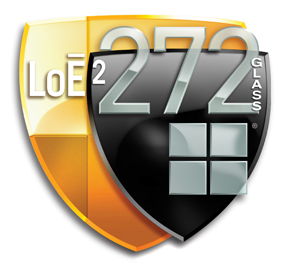
Solar Block LoĒ 3-366
LoĒ 3-366 is an excellent solution that prevents summertime overheating problems and excessive cooling loads. With three layers of silver applied to the glass, this coating delivers excellent insulation values and solar heat gain control, while maintaining good visibility.
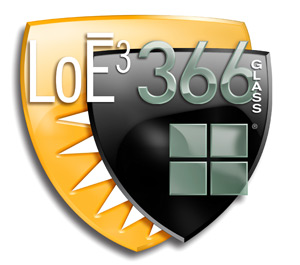
Solar Gain LoĒ-180
With a glass U-value of 0.26 btu/hr•ft²•°F and an SHGC of 0.69, LoĒ-180 is an excellent product for passive solar applications. It blocks heat loss, while letting the sun’s heat stream inside. LoĒ-180 also lets in more light than ordinary Lo-E products – turn off artificial lighting and enjoy natural light.
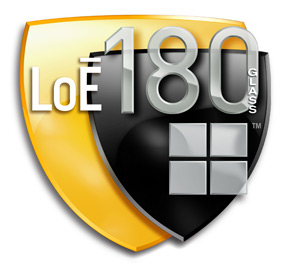
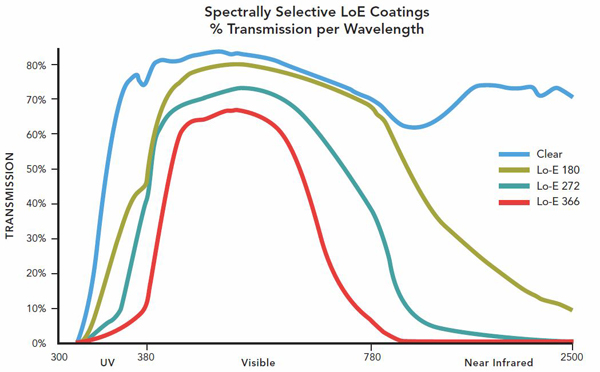
Compare Visible Light Transmittance
Lo-E coatings combined with clear glass in a dual pane

Insulating Glass Spacers
back to top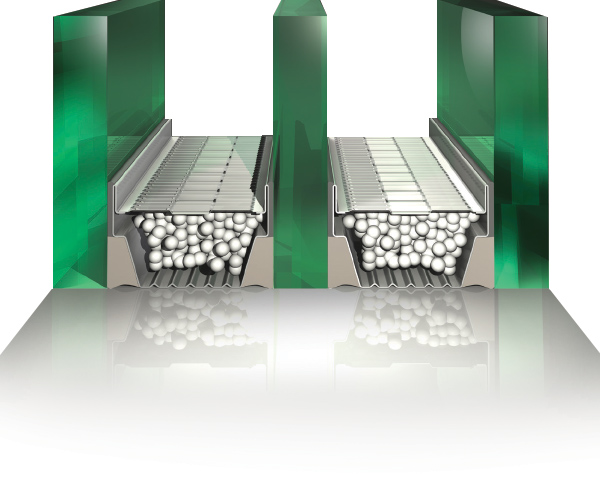
How to Choose the Right Insulating Glass
back to topMany building owners have heard that they should have insulating glass units with LoĒ coatings and argon gas. However, with the changing seasons, different elevation orientations, and varying design details, a more carefully considered analysis of insulating glass options will definitely pay off.
Different orientations are subject to different amounts of sunlight throughout the year. A varied, carefully considered glass selection will have minimal price increases, while lowering energy bills, maximizing visible light, and increasing comfort in a home.
Objectives by Elevation in North America
North:
Minimize U-value (Maximize R-value) for reduced heat loss.
- Minimal opportunity for solar gain due to the sun’s southern path in the winter.
South:
Take advantage of optimal solar heat gain and visible light.
- Because the winter sun’s path travels low in the sky, you can take advantage of its heat in cold winter months. Roof overhangs and deciduous trees can provide protection from overheating in the summer. Note: True passive solar design includes considerations such as glass area, room size, and a heat collection system.
- Very large areas of glass area relative to the room area, however, may run the risk of overheating the room, and should be evaluated by an industry professional to determine the right type of insulating glass. Mid- to lower-range Solar Heat Gain Coefficient (SHGC) glass may be required to minimize cooling load and even reduce the capital cost of the HVAC system.
East:
Aim for a mid-range product.
- Increase the R-value for reduced heat loss and select a mid-range Solar Heat Gain Coefficient (SHGC) to block heat in the summer.
West:
Control solar heat gain.
- In the summer, the sun’s path travels higher in the sky, and will primarily affect West-facing glass in the afternoon. Minimize solar heat gain to avoid excessive cooling costs in the summer.
There are typically trade-offs between R-values and passive solar heat gain properties. Generally, the higher the insulation value, the less the opportunity for passive solar gain.
Custom Solutions
back to topFor projects with unique performance requirements, DUXTON has worked closely with architects and engineers to deliver very unique glass configurations. Challenge DUXTON to provide your solution today!
- 6 mm or 8 mm triple pane units
- Heat strengthened or tempered glass
- Laminated glass
- Security screens
- Low-iron glass
- Bronze reflective glass
- Bronze tinted glass
- Other details as required
